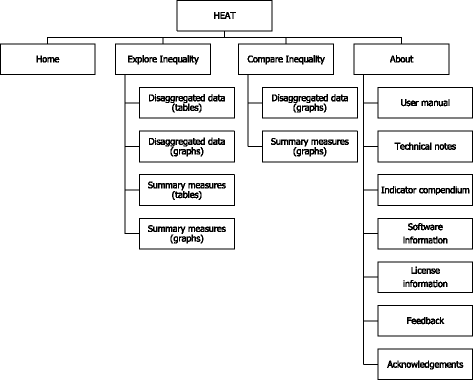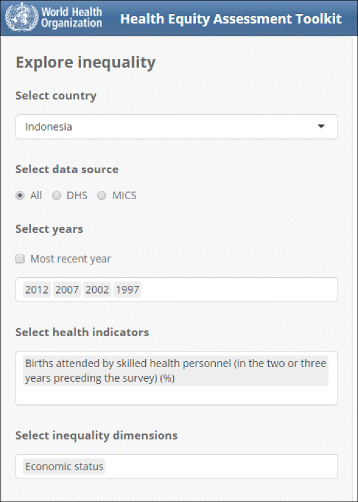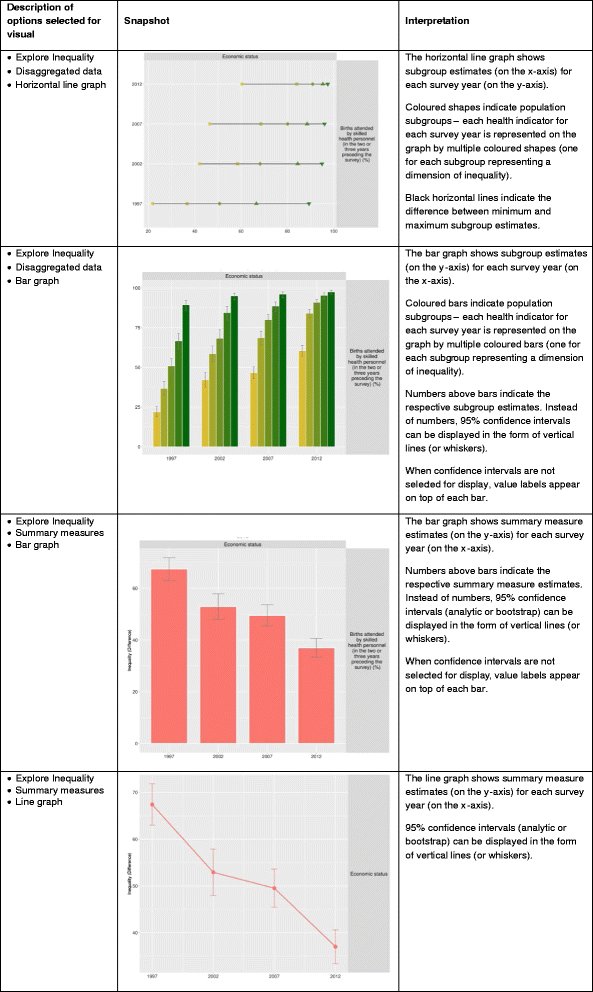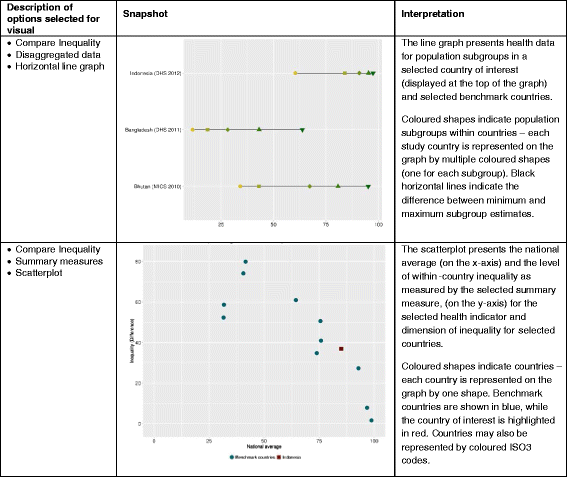Health Equity Assessment Toolkit (HEAT): software for exploring and comparing health inequalities in countries
- PMID: 27760520
- PMCID: PMC5069829
- DOI: 10.1186/s12874-016-0229-9
Health Equity Assessment Toolkit (HEAT): software for exploring and comparing health inequalities in countries
Abstract
Background: It is widely recognised that the pursuit of sustainable development cannot be accomplished without addressing inequality, or observed differences between subgroups of a population. Monitoring health inequalities allows for the identification of health topics where major group differences exist, dimensions of inequality that must be prioritised to effect improvements in multiple health domains, and also population subgroups that are multiply disadvantaged. While availability of data to monitor health inequalities is gradually improving, there is a commensurate need to increase, within countries, the technical capacity for analysis of these data and interpretation of results for decision-making. Prior efforts to build capacity have yielded demand for a toolkit with the computational ability to display disaggregated data and summary measures of inequality in an interactive and customisable fashion that would facilitate interpretation and reporting of health inequality in a given country.
Methods: To answer this demand, the Health Equity Assessment Toolkit (HEAT), was developed between 2014 and 2016. The software, which contains the World Health Organization's Health Equity Monitor database, allows the assessment of inequalities within a country using over 30 reproductive, maternal, newborn and child health indicators and five dimensions of inequality (economic status, education, place of residence, subnational region and child's sex, where applicable).
Results/conclusion: HEAT was beta-tested in 2015 as part of ongoing capacity building workshops on health inequality monitoring. This is the first and only application of its kind; further developments are proposed to introduce an upload data feature, translate it into different languages and increase interactivity of the software. This article will present the main features and functionalities of HEAT and discuss its relevance and use for health inequality monitoring.
Figures
Similar articles
-
Health Equity Assessment Toolkit Plus (HEAT Plus): software for exploring and comparing health inequalities using uploaded datasets.Glob Health Action. 2018;11(sup1):1440783. doi: 10.1080/16549716.2018.1440783. Glob Health Action. 2018. PMID: 29974823 Free PMC article.
-
Social inequality in infant mortality in Angola: Evidence from a population based study.PLoS One. 2020 Oct 22;15(10):e0241049. doi: 10.1371/journal.pone.0241049. eCollection 2020. PLoS One. 2020. PMID: 33091077 Free PMC article.
-
Health Equity Assessment Toolkit (HEAT and HEAT Plus): exploring inequalities in the COVID-19 pandemic era.Int J Equity Health. 2022 Dec 5;21(Suppl 3):172. doi: 10.1186/s12939-022-01765-7. Int J Equity Health. 2022. PMID: 36471346 Free PMC article.
-
Summary Measures of Health Inequality: A Review of Existing Measures and Their Application.Int J Environ Res Public Health. 2022 Mar 20;19(6):3697. doi: 10.3390/ijerph19063697. Int J Environ Res Public Health. 2022. PMID: 35329383 Free PMC article. Review.
-
Strengthening and expanding health inequality monitoring for the advancement of health equity: a review of WHO resources and contributions.Int J Equity Health. 2023 Mar 17;22(1):49. doi: 10.1186/s12939-022-01811-4. Int J Equity Health. 2023. PMID: 36932363 Free PMC article. Review.
Cited by
-
Socioeconomic, urban-rural and sex-based inequality in infant mortality rate: evidence from 2013 Yemen demographic and health survey.Arch Public Health. 2021 Apr 29;79(1):64. doi: 10.1186/s13690-021-00589-1. Arch Public Health. 2021. PMID: 33926550 Free PMC article.
-
Trends and inequalities in neonatal mortality rate in Bangladesh: Evidence from cross-sectional surveys.Health Sci Rep. 2024 Aug 8;7(8):e2298. doi: 10.1002/hsr2.2298. eCollection 2024 Aug. Health Sci Rep. 2024. PMID: 39131597 Free PMC article.
-
Changing relative and absolute socioeconomic health inequalities in Ontario, Canada: A population-based cohort study of adult premature mortality, 1992 to 2017.PLoS One. 2020 Apr 2;15(4):e0230684. doi: 10.1371/journal.pone.0230684. eCollection 2020. PLoS One. 2020. PMID: 32240183 Free PMC article.
-
Sex-related inequalities in crude and age-standardized suicide rates: trends in Ghana from 2000 to 2019.BMC Public Health. 2024 Apr 17;24(1):1070. doi: 10.1186/s12889-024-18516-8. BMC Public Health. 2024. PMID: 38632578 Free PMC article.
-
Socioeconomic and geographical inequalities in polio immunisation coverage among two-year-olds in Sierra Leone, 2008-2019.BMC Infect Dis. 2024 Dec 24;24(1):1461. doi: 10.1186/s12879-024-10381-5. BMC Infect Dis. 2024. PMID: 39719550 Free PMC article.
References
-
- Transforming our world: the 2030 Agenda for Sustainable Development. New York: United Nations; 2015. https://sustainabledevelopment.un.org/post2015/transformingourworld. Accessed 29 Apr 2016.
-
- World Health Statistics 2016. Monitoring health for the SDGs. Geneva: World Health Organisation; 2016. http://www.who.int/gho/publications/world_health_statistics/2016/en/. Accessed 26 Sept 2016.
Publication types
MeSH terms
Grants and funding
LinkOut - more resources
Full Text Sources
Other Literature Sources
Medical





